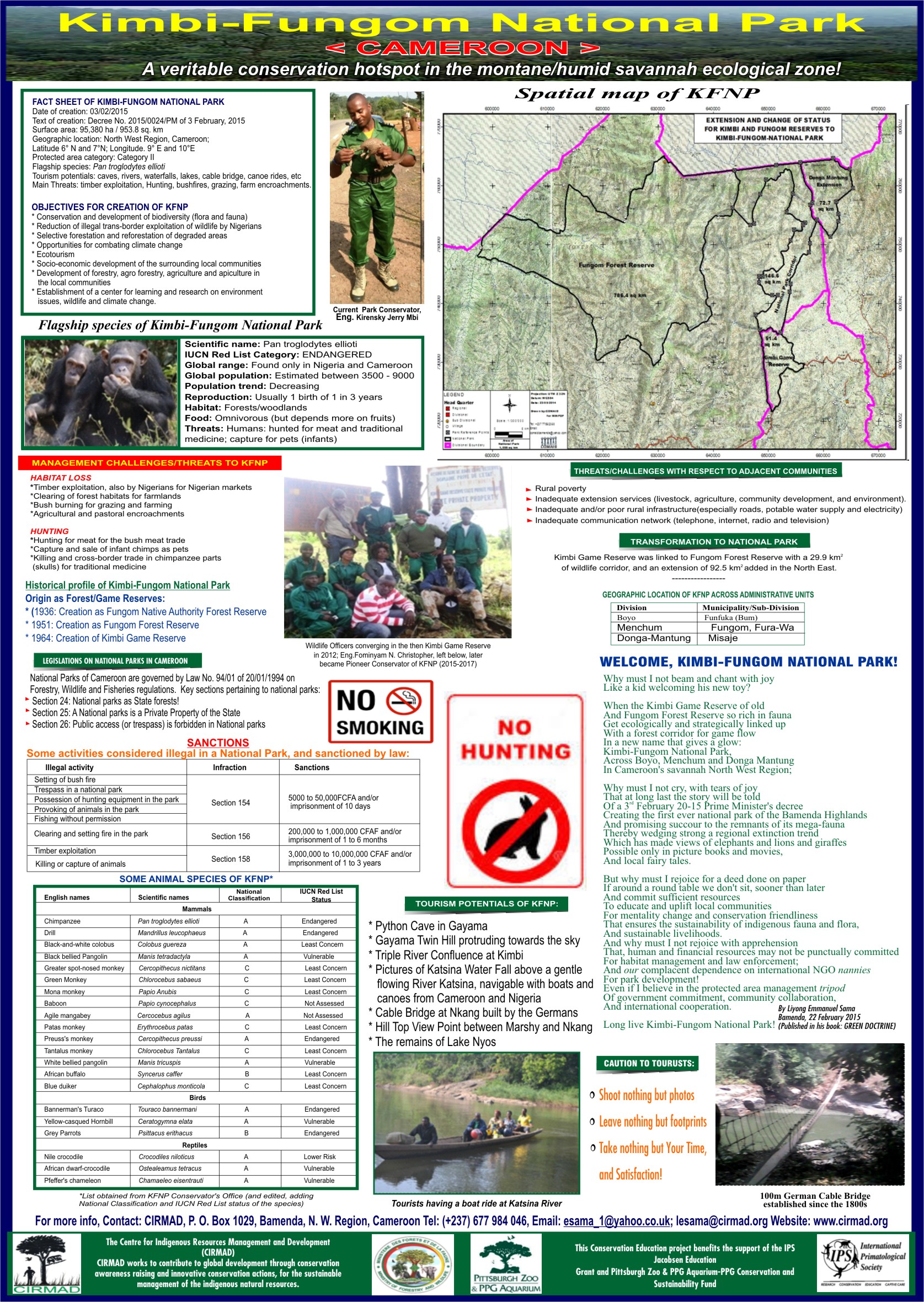A JEWEL INSIDE THORNS – THE CASE OF THE KIMBI-FUNGOM NATIONAL PARK IN CONFLICT-STRICKEN NORTH WEST CAMEROON
INTRODUCTION
This article is based on how the Centre for Indigenous Resources Management and Development (CIRMAD) has contributed to the conservation of the Kimbi-Fungom National Park of Cameroon, with a 2018 IPS – Lawrence Jacobsen Education grant. The grant was for a project titled: Production of an informative poster for awareness raising and conservation education on newly created Kimbi-Fungom National Park. This was a conservation education project for the production and distribution of 750 copies of an educational poster to raise conservation awareness on the new national park.
This article relates how the work was carried out, the successes and constraints.
RATIONALE
The rationale is that the Kimbi-Fungom National Park (KFNP) of 95,380 ha, which was created on 3rd February 2015 by fussing the then Kimbi Game Reserve and the Fungom Forest Reserve (which lies along a long porous international boundary with Nigeria), suffers from much human pressure. Besides habitat loss through timber exploitation, farm encroachment, livestock grazing and uncontrolled bush burning, the new, upgraded protected area is threatened with the poaching of chimpanzees for the international trade in its medicinal parts, mainly the split and smoked skulls (Conservator Report, 2016). The Regional Action Plan for the Conservation of the Nigeria-Cameroon Chimpanzee (Morgan et al, 2011) had recognized the then Fungom Forest Reserve as an important chimpanzee conservation site. Because the threat of extinction of the Endangered Nigeria-Cameroon chimpanzee (Pan troglodytes ellioti) in the Kimbi-Fungom National Park is due to human causes, conservation education is a necessary measure to address the problem. We had chosen to use a printed poster to permanently display every aspect of the site, including threats, legislation in force, in informative graphics and alert messages. Besides being distributed to schools, palaces, churches offices, households and public spots, it has been shared online to the global conservation family.
The main project goal was for the general public, and especially the adjacent communities to become more aware of the conservation concern for the indigenous chimpanzee, adopt conservation-friendly lifestyles and support conservation actions to ensure its continued survival.
PROJECT ACHIEVEMENTS
The projected educational poster was produced in 1000 copies (being 750 with IPS – Lawrence Jacobsen Education Development Grant and 250 from the Pittsburgh Zoo & PPG Aquarium’s PPG Conservation and Sustainability Fund) and widely distributed as planned.
Though not projected during project conception, the produced poster looked so good and useful that the Regional Delegate of Forestry and Wildlife for the North West Region requested that the historic, educational poster be distributed to all reachable tourism promotion outfits, which we did, to hotels, tour guide services, etc.

CONSTRAINTS
The project had been designed when the Anglophone Crisis in Cameroon had not yet degenerated into the level of armed conflict in which it is today, whereby conservators and their personnel have had to escape to the safer cities. (See <http://www.cameroon-info.net/article/cameroon-anglophone-crisis-environmentalists-express-fear-over-future-of-endangered-species-as-population-invade-339156.html>).
As such, the distribution in the adjacent communities which were envisaged to be during village sensitization meetings (VSM) could not be fully realized, because we resorted to distributing them through contracted intermediaries and to internally displaced persons from the area.
Consequently, the envisaged evaluation of conservation impact of the conservation education project could not be realized, as no project staff could dare travel to the adjacent communities of the park. Any evaluation report would be highly biased.
CONCLUDING COMMENTS
In spite of our inability to directly reach the adjacent communities of the new national park, due to the armed conflict, the multi-faceted educational poster of the new national park has been a unique case of pointing a sun-like torch onto a prized jewel shadowed inside a thorny bush! For that is the situation of the newly created and lone national of the savannah North West Region of Cameroon now under armed conflict. The poster also aptly contributes to the post-crisis measures for biodiversity conservation in the conflict-stricken zones.
ACKNOWLEDGEMENT
And we are very thankful for the support of the IPS – Lawrence Jacobsen Education Development Grant that made this novel project the success it has been.
By Liyong Emmanuel Sama
